Salamander Behavior and Life History - Feeding and Predators


| Feeding Behavior | |||||
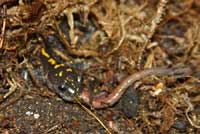 |
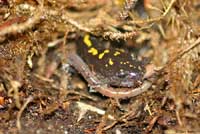 |
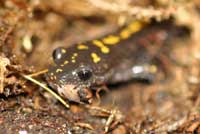 |
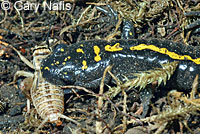 |
||
| An adult Central Long-toed Salamander eating an earthworm. | An adult Central Long-toed Salamander eating a cricket. | ||||
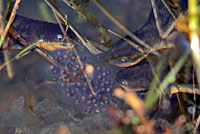 |
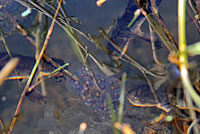 |
Video 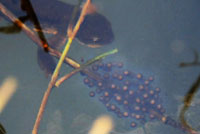 |
 |
||
| Several breeding adult Rough-skinned Newts in a breeding pond, lunge at the eggs of another amphibian, probably Northwestern Salamander or Western Long-toed Salamander eggs. It looks like they are trying to eat the eggs, but it does not appear that they are succeeding. | Max Kelley found this adult California Giant Salamander eating a large rodent, possibly a Wood Rat, one late November day. In this picture, only the rodent's long tail is still visible. © Max Kelley |
||||
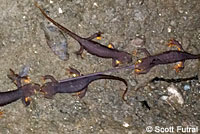 |
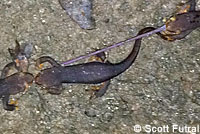 |
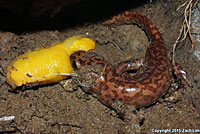 |
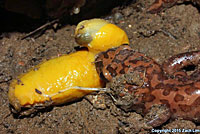 |
||
| These California Newts appear to be stretching an earthworm and struggling to see which one gets to eat it. © Scott Futral |
Sub-adult California Giant Salamander eating a Banana Slug in San Mateo County © Zach Lim |
||||
 |
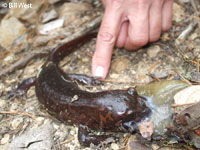 |
 |
 |
||
| This California Giant Salamander was found on a hiking trail in Marin County on a foggy mid May afternoon wet with fog drip. It was observed for about 20 minutes as it slowly attempt to eat the banana slug. Banana slugs are very sticky and their slime causes numbness, which makes it difficult to swallow them. © Bill West |
|||||
 |
 |
 |
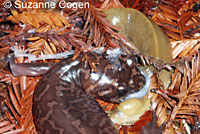 |
||
| Adult newt eating a very large worm in Mendocino County © Amelia True | Suzanne Cogen © found this California Giant Salamander eating a Banana Slug at 3 PM in mid December in Sonoma County. | ||||
 |
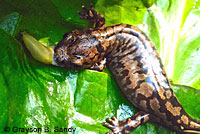 |
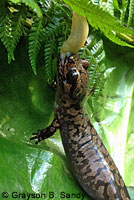 |
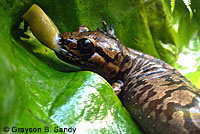 |
||
| Nancy Gribler discovered this large adult California Giant Salamander eating a Banana Slug one night in her back yard. © Nancy Gribler |
Adult Coastal Giant Salamander eating a Banana Slug © Grayson B. Sandy | ||||
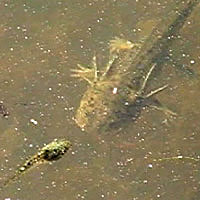 |
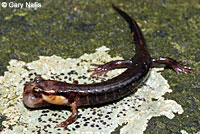 |
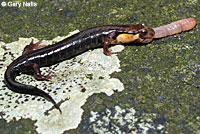 |
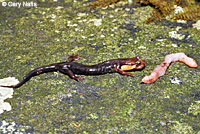 |
||
| In this video, California Tiger Salamander larvae swim around a murky pool, rising to the surface for a gulp of air and to try to eat Sierran Treefrog tadpoles, with no success. |
This adult Imitator Salamander regurgitated a worm after it was discovered. | ||||
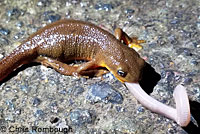 |
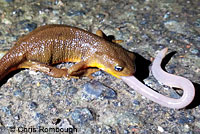 |
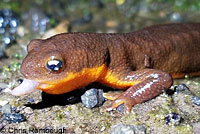 |
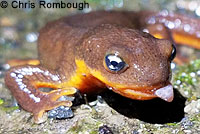 |
||
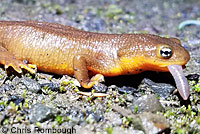 |
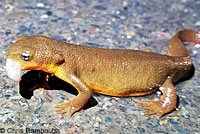 |
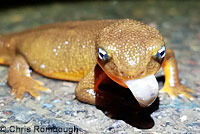 |
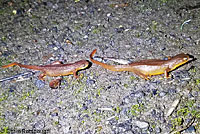 |
||
| The eight pictures above show several Rough-skinned Newts eating earthworms on a road at night in Marion County, Oregon. They were among more than a thousand adult female newts that had migrated out onto the road on two rainy nights in late January & early February to take advantage of the worms which had crawled onto the road. The females were feeding before heading to the breeding pond, which was already full of males awaiting their arrival. © Chris Rombough | |||||
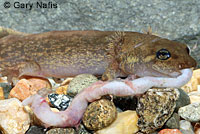 |
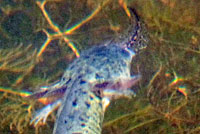 |
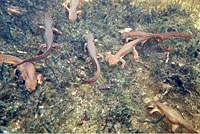 |
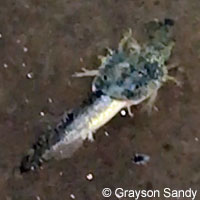 |
||
| A mature Coastal Giant Salamander larva regurgitating a worm | This mature California Tiger Salamander larva is eating a Sierran Treefrog tadpole. © Mark Gary | This short video shows several Rough-skinned newts in a Tillamook Co., Oregon coastal lake, 3.5 feet offshore and in 12" deep water feeding on largemouth bass eggs, most less than 1 mm in diameter. Male largemouth bass construct a nest where the female lays her eggs. It is often a circular depression in the substrate or a patch of submerged vegetation. In this case the nest is the patch of moss in which we see the newts, and the eggs are sticking to the strands. © Chris Rombough |
This short video shows a California Tiger Salamander larva cannibalizing another California Tiger Salamander larva. © Grayson Sandy |
||
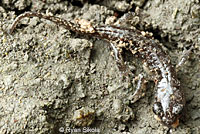 |
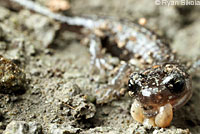 |
 |
 |
||
| Juvenile Arboreal Salamander eating an insect larva or worm in San Luis Obispo County © Ryan Sikola | |||||
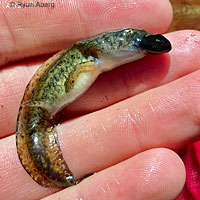 |
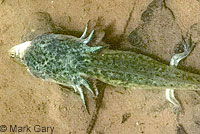 |
||||
| Mature Southern Long-toed Salamander larva eating a Boreal Toad tadpole, 5,800 ft. Shasta County © Ryan Aberg |
A mature California Tiger Salamander larva eats a Sierran Treefrog tadpole. © Mark Gary |
||||
| Salamander Predators | |||||
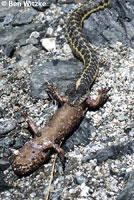 |
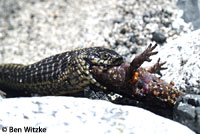 |
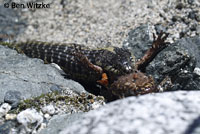 |
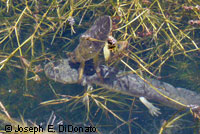 |
||
| Oregon Gartersnake, Thamnophis atratus hydrophilus, eating a neotenic Coastal Giant Salamander, Dicamptodon tenebrosus, in Trinity County. © Ben Witzke |
Salamander larvae are preyed upon by vertebrates and also some non-vertebrates: this California Tiger Salamander larva has been caught by a Giant Water Bug nymph, (Lethocerus sp.) which will kill it by injecting a digestive saliva then sucking out the liquefied remains. © Joseph E. DiDonato |
||||
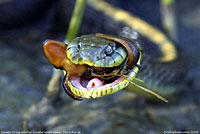 |
 |
 |
 |
||
| Two views of a Santa Cruz Gartersnake eating a newt. The newt is either a Rough-skinned Newt or a California Newt. Both are extremely poisonous to most animals, including humans, but the gartersnake is immune to this poison. © Odophile.com |
An adult San Bernardino Ring-necked snake eating an adult Arboreal Salamander in Los Angeles County © Jonathan Benson |
||||
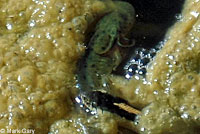 |
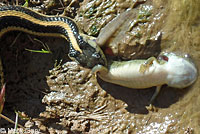 |
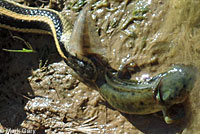 |
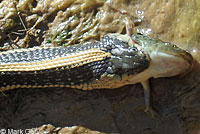 |
||
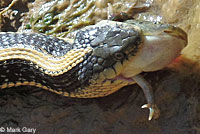 |
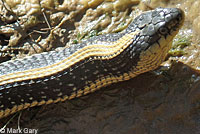 |
||||
| This series shows a Diablo Range Gartersnake eating a California Tiger Salamander larva in Contra Costa County. The snake caught the larva in the water, then brought it to shore to swallow it. © Mark Gary |
|||||
 |
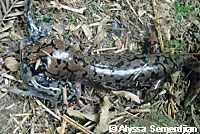 |
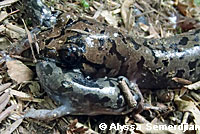 |
|||
| Adult Terrestrial Gartersnake eating a toxic California Newt in San Luis Obispo County © Ryan Sikola You can read about gartersnakes eating toxic newts here. |
These two Coastal Giant Salamanders were found locked in combat beside a coastal creek in Humboldt County in mid July in what is probably an attempt by the large salamander to eat the smaller salamander. The smaller salamander bites onto the large salamanders leg while the large salamder bites onto its middle. © Alyssa Semerdjian |
||||
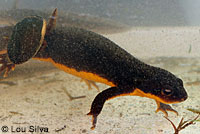 |
 |
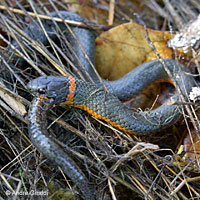 |
|||
| This adult Rough-skinned Newt (shown in water) is being attacked by a predatory diving beetle. © Lou Silva | This short video shows a California Tiger Salamander larva cannibalizing another California Tiger Salamander larva. © Grayson Sandy |
A Pacific Ring-necked Snake eating a California Slender Salamander in Marin County © Andre Giraldi | |||
 |
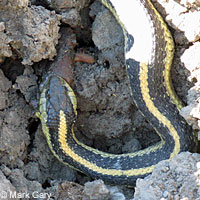 |
 |
|||
 |
 |
 |
s | ||
| This Diablo Range Gartersnake was observed in October eating a toxic California Newt in Alameda County at the edge of a newt breeding pond. You can see the snake biting the tail, then swallowing the newt tail first and then the head. You can read about gartersnakes eating toxic newts here. © Mark Gary |
|||||
 |
 |
 |
|||
| This tiny juvenile Diablo Range Gartersnake was observed in December eating a recently-transformed juvenile California Newt on the edge of the same newt breeding pond in Alameda County where the adult snake above was observed eating an adult newt. © Mark Gary | |||||
Return to the Top
© 2000 -
